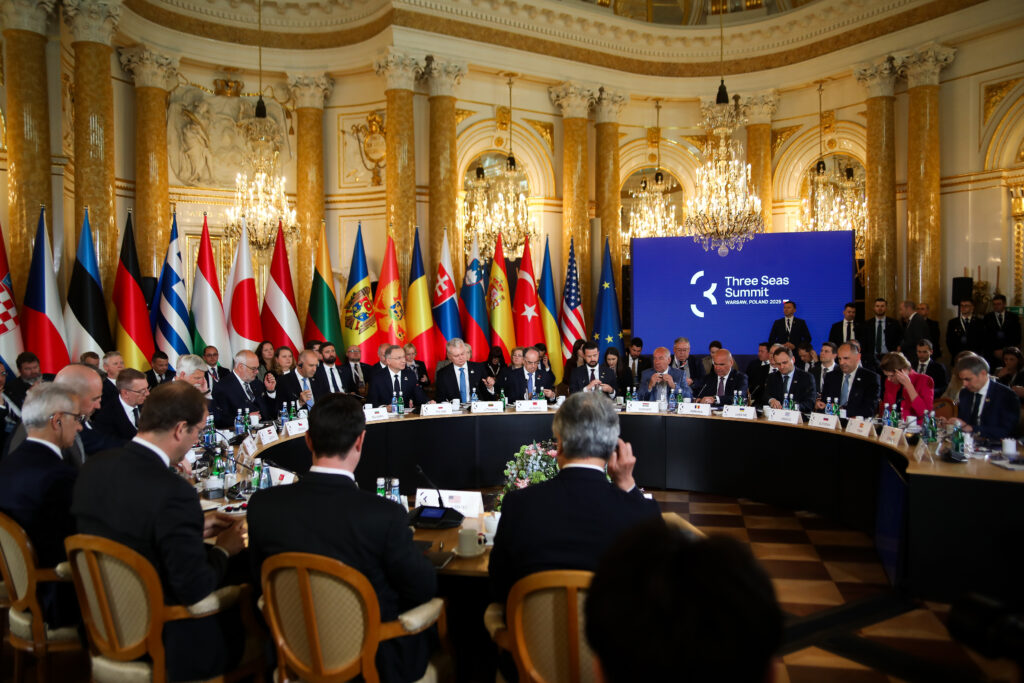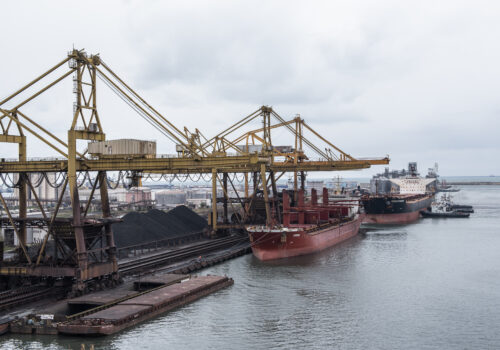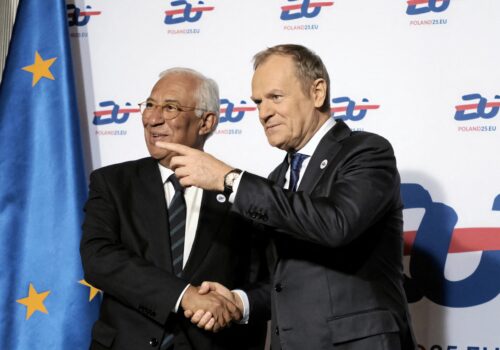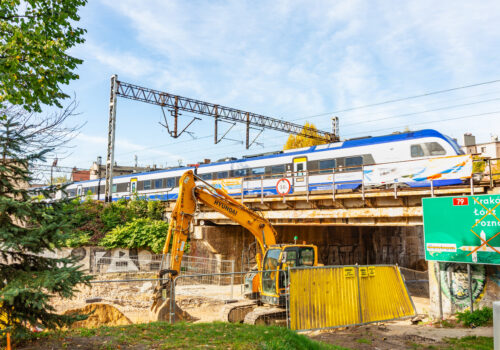Since its launch ten years ago, the Three Seas Initiative (3SI) has established itself as a novel, network-driven platform that enhances north–south connectivity among thirteen European Union (EU) member states located between the Baltic, Adriatic, and Black seas. A large part of its success has been due to its narrow scope, namely connectivity across the energy, transport, and digital sectors. However, with mounting geopolitical pressure along Europe’s eastern flank, these same sectors in 3SI countries are increasingly targeted by hostile hybrid activities. To effectively address the evolving security challenges—particularly those aimed at critical energy, transport, and digital infrastructure—the 3SI should add defense innovation as another pillar of its mission.
By leveraging its existing strengths, the 3SI can accelerate the development and cross-border deployment of advanced security and defense technologies to help protect critical infrastructure. This would significantly bolster regional resilience and help deter threats operating in the “gray zone” between civilian and military domains. With shared threat perceptions and strategic alignment, 3SI member states—supported by key partners such as the United States, Germany, the European Commission, Japan, and Ukraine—are uniquely positioned to confront these challenges.
The best way for the 3SI to proceed is by creating a 3SI Defense Innovation Hub that cuts across the three existing pillars of energy, transport, and digital. Devoted to developing cutting-edge technologies for critical infrastructure protection, the 3SI Defense Innovation Hub would contribute to the much-needed paradigm shift in the overall approach to connectivity projects. It would do this by incorporating tools and processes for protection from the very outset of infrastructure planning.
Moreover, the 3SI Defense Innovation Hub could evolve into a key specialized critical infrastructure protection node within a broader allied defense innovation ecosystem, spanning from North America to Europe to the Indo-Pacific. In doing so, it could help serve as a strategic counterweight to the deepening defense-industrial cooperation and hybrid warfare efforts of Russia, China, North Korea, and Iran.
A region under attack
Across the 3SI region, Russia-backed saboteurs have increasingly targeted energy infrastructure as part of hybrid campaigns aimed at undermining societal resilience and inflicting economic harm. Undersea pipelines and power cables in the Baltic Sea have suffered clandestine cuts and physical damage, prompting NATO and littoral states to launch dedicated missions to safeguard these vital links.
On land, arson attacks and hoax bomb threats, including waves of coordinated false alarms at Lithuanian schools, airports, and governmental institutions, have become widespread phenomena. While delivering no physical destruction, these false alarms incidents have strained security services and revealed gaps in crisis-response protocols.
In the transport domain, rail lines across the 3SI region and in Germany have been subject to sabotage attempts aimed at fracturing strategic north–south corridors. In addition, GPS jamming—likely from Russian electronic-warfare units in Kaliningrad—has repeatedly degraded navigation for commercial shipping and civilian flights in the Baltic Sea region. This jamming has forced in-flight diversions and resulted in aborted landings. Potentially more destructive planned attacks have thankfully been detected before being carried out. Earlier this month, for example, three men were arrested in an alleged Russia-linked plot to place parcels with explosives on cargo planes traveling from Europe to the United States and Canada.
The digital battlefield in 3SI countries has become equally contested. For example, cyberattacks have targeted governmental institutions in the Czech Republic, Germany, and Latvia, as well as energy-sector operators in Romania, exploiting unpatched systems to plant malware or launch distributed denial-of-service attacks. Chinese cargo and Russian “shadow fleet” vessels maneuvering in the Baltic Sea are suspected of cutting undersea data cables, as well, posing a threat to digital connectivity in the region.
Collectively, these hybrid threats expose the vulnerability of siloed infrastructure sectors and underscore the urgent need for the 3SI to integrate defense-grade innovations into its energy, transport, and digital development agenda.
Incorporating defense from the start
Critical civilian infrastructure in the energy, transport, and digital domains no longer exists in isolation from the military domain—the domains have merged into a single battlefield of resilience and readiness. Power grids and pipelines, once engineered solely for economic efficiency, must now be designed with embedded defensive features. This includes hardened control systems, automated isolation protocols, and redundant interconnects that can withstand kinetic strikes, physical impact, or cyber-enabled sabotage.
Likewise, north–south transport corridors can no longer be planned as purely commercial arteries: They must accommodate the rapid deployment of heavy armor, pre-positioned logistics modules, and secure communications nodes, all while deterring adversarial probes or hybrid ambushes.
This is the area in which the 3SI has already recognized its role, as evident in its 2024 Joint Declaration, which reaffirms the need to strengthen “the resilience of dual-use infrastructure in the region for enhanced civilian and military mobility along the North-South axis.” However, if established, the proposed 3SI Defense Innovation Hub should go further and offer solutions not only for upgrading new transport infrastructure for a dual civil-military use, but also for effectively protecting it from physical and cyber sabotage.
True resilience requires that innovation for the protection of critical infrastructure be integral to the earliest design and development phases of the 3SI’s infrastructure. An alternative, retrofitting “defense layers” onto critical infrastructure systems after their construction has been finalized, often creates significant security gaps and increases costs. It’s better to incorporate these aspects from the start.
The bigger picture
The 3SI’s broad partnership network—anchored by the United States, Germany, the European Commission, Japan, and enriched by Ukraine—provides an unparalleled foundation for extending its remit into defense innovation and contributing to the broader goal of transatlantic defense-industrial alignment.
With Russia’s war against Ukraine transforming the way war is fought and placing constant pressure on Ukraine’s critical energy infrastructure, Europe must adapt its technologies and defense strategies to prepare to confront similar challenges. Learning from Ukraine, which, under constant attack, has become a real-time innovation lab for unmanned systems, energy resilience solutions, and rapid infrastructure repairs, is essential.
With Chinese coercion and sabotage around Taiwan posing similar threats to regional stability, it is clear that a broader adversarial strategy is at play. As the European and Indo-Pacific theaters become increasingly interconnected due to similar security challenges, it will be necessary for European countries, the United States, and democratic nations in the Indo-Pacific to align their responses.
In the meantime, the United States and the EU are searching for common ground in aligning their defense industries. However, tensions have persisted, particularly around new EU funding mechanisms, which are often perceived in Washington as favoring domestic European firms at the expense of transatlantic cooperation.
This is where the 3SI can play a pivotal role. By launching a Defense Innovation Hub focused on critical infrastructure protection, the 3SI could serve as a catalyst for deeper transatlantic defense-industrial alignment. Such a hub would help bridge regulatory, political, and operational gaps, offering a constructive step forward in building a truly interoperable, forward-leaning allied defense ecosystem in a common effort to outpace and out-innovate authoritarian challengers.
The way forward
The upcoming Croatian presidency of the 3SI in 2026—marking the tenth anniversary of the initiative’s inaugural summit in Dubrovnik—offers a timely opportunity to expand the initiative’s mission to include defense innovation.
Building on its success in infrastructure development, the 3SI should replicate its network-based model in the defense sector—pooling risk and capital among governments, private industry, and financial institutions. This would unlock dual-use innovation pipelines that are often too complex or costly for individual actors to pursue alone. The recently launched 3SI Innovation Fund offers a promising starting point for exploring sustainable financing mechanisms to support the activities of a potential 3SI Defense Innovation Hub.
As the geopolitical landscape grows more contested, the 3SI should evolve from a connectivity-focused platform into a strategic driver of allied resilience. A dedicated Defense Innovation Hub would make the 3SI a force multiplier for NATO and EU efforts—accelerating deterrence, deepening regional interoperability, and embedding security into the DNA of the eastern flank’s critical infrastructure while at the same time providing a much-needed push for a transatlantic defense-industrial alignment.
Justina Budginaite-Froehly is a nonresident senior fellow with the Atlantic Council’s Europe Center and Transatlantic Security Initiative within the Scowcroft Center for Strategy and Security.
Further reading
Tue, May 21, 2024
Bridging the Baltic, Black, and Adriatic seas would serve both European and NATO interests
New Atlanticist By
Strategic corridors linking Constanța, Gdańsk, and Trieste would be transformative force multipliers for European peace and prosperity.
Mon, Jan 6, 2025
What to expect from Poland’s EU presidency and its focus on ‘Security, Europe!’
New Atlanticist By Aaron Korewa
Poland sought a leadership role in Europe, and now it has one as it takes up the six-month presidency of the Council of the European Union.
Fri, Mar 14, 2025
The Three Seas Initiative stands at an inflection point
Issue Brief By Emma Nix, Ian Brzezinski
The Three Seas Initiative is preparing for a critical summit in Warsaw in 2025. What opportunities exist to ensure the Initiative can accomplish its goal of ensuring a Europe whole, free, secure, and at peace?
Image: Presidents and guests attend the plenary session of the 10th Three Seas Initiative Summit at the Royal Castle in Warsaw, Poland, on April 29, 2025. The establishment of the Three Seas Initiative is initiated by the Presidents of Poland, Andrzej Duda, and Croatia, Kolinda Grabar-Kitarovic, and the inaugural summit of the Initiative takes place in Dubrovnik in 2016. It is an international economic and political initiative. The Initiative currently brings together 13 participating countries. (Photo by Klaudia Radecka/NurPhoto) via REUTERS




